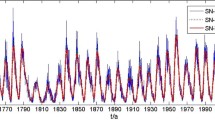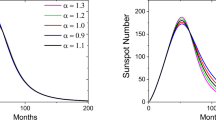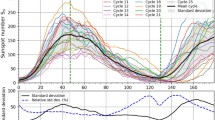Abstract
The smoothed monthly sunspot numbers of the new version in each solar cycle can be well fitted by a four-parameter modified Gaussian function, with a correlation coefficient around 0.986. A longer tail tends to be related to a larger amplitude, a narrower width, and a shorter rise time of the shape. This function can be simplified to a two-parameter function using the Waldmeier effect and the anticorrelation between the asymmetry and width of the shape, and can also be reduced into a one-parameter function with the peak value as the only free parameter. The two- and one-parameter functions are much superior to the four-parameter function in predicting the maximum amplitude (\(S_{\mathrm{m}}\)) and rise time (\(T_{\mathrm{a}}\)) of the cycle, although the former two are slightly inferior to the latter in fitting the shape of the cycle (\(r\approx 0.958\) and 0.949). The one-parameter function is similar to the two-parameter function in predicting \(S_{\mathrm{m}}\) and \(T_{\mathrm{a}}\). For the two-parameter function, the mean relative prediction errors of \(S_{\mathrm{m}}\) over the last ten cycles are 15.2%, 11.9%, 11.6%, 10.7%, 7.9%, and 4.8% at \(m=18\), 24, 30, 36, 42, and 48 months into the cycle, respectively, and the MSE skill score is larger than 0.7 if \(m\geqslant 22\). The mean absolute (relative) prediction error of \(T_{\mathrm{a}}\) is around 5.5 months (11%) since \(m=24\) and the MSE skill score is around 0.58. Using the data available at the current time, cycle 25 is predicted to peak around October (\(\pm 7\) months) 2024 with a maximum amplitude of \(124\pm 30\).









Similar content being viewed by others
Data Availability
The data used in this study are downloaded from the Sunspot Index and Long-term Solar Observations website (https://wwwbis.sidc.be/silso/DATA/SN_ms_tot_V2.0.txt).
References
Chowdhury, P., Kilcik, A., Yurchyshyn, V., Obridko, V.N., Rozelot, J.P.: Sol. Phys. 294, 142 (2019)
Cole, T.W.: Sol. Phys. 30, 103 (1973)
Clette, F., Cliver, E., Lefèvre, L., Svalgaard, L., Vaquero, J., Leibacher, J.: Sol. Phys. 219, 2479 (2016)
Clette, F., Lefèvre, L.: Sol. Phys. 291, 2629 (2016)
Du, Z.L.: Sol. Phys. 273, 231 (2011)
Du, Z.L.: Astrophys. J. 804, 3 (2015)
Du, Z.L.: Sol. Phys. 295, 134 (2020a)
Du, Z.L.: Sol. Phys. 295, 147 (2020b)
Du, Z.L.: Astrophys. Space Sci. 365, 104 (2020c)
Du, Z.L., Wang, H.N.: Sci. China, Ser. G, Phys. Mech. Astron. 55, 365 (2012)
Elling, W., Schwentek, H.: Sol. Phys. 137, 155 (1992)
Forgács-Dajka, E., Dobos, L., Ballai, I.: Astron. Astrophys. 653, A50 (2021)
Hathaway, D.H.: Living Rev. Sol. Phys. 7, 1 (2010)
Hathaway, D.H., Upton, L.A.: J. Geophys. Res. 121, 10,744 (2016)
Hathaway, D.H., Wilson, R.M., Reichmann, E.J.: Sol. Phys. 151, 177 (1994)
Hiremath, K.M.: Astrophys. Space Sci. 314, 45 (2008)
Javaraiah, J.: New Astron. 34, 54 (2015)
Kakad, B., Kakad, A.: Planet. Space Sci. 209, 105359 (2021)
Kane, R.P.: Sol. Phys. 246, 487 (2007)
Kimura, H.: Mon. Not. R. Astron. Soc. 73, 543 (1913)
Kumar, P., Nagy, M., Lemerle, A., Karak, B.B., Petrovay, K.: Astrophys. J. 909, 87 (2021)
Li, F.Y., Xiang, N.B., Kong, D.F., Xie, J.L.: Astrophys. J. 834, 192 (2015)
Murphy, A.H., Epstein, E.S.: Mon. Weather Rev. 117, 572 (1989)
Nordemann, D.J.R.: Sol. Phys. 141, 199 (1992)
Nordemann, D.J.R., Trivedi, N.B.: Sol. Phys. 142, 411 (1992)
Pesnell, W.D.: Sol. Phys. 252, 209 (2008)
Pesnell, W.D., Schatten, K.H.: Sol. Phys. 293, 112 (2018)
Petrovay, K.: Living Rev. Sol. Phys. 17, 2 (2020)
Petrovay, K., Nagy, M., Gerják, T., Juhász, L.: J. Atmos. Sol.-Terr. Phys. 176, 15 (2018)
Qin, G., Wu, S.-S.: Astrophys. J. 869, 48 (2018)
Sabarinath, A., Anilkumar, A.K.: Sol. Phys. 250, 183 (2008)
Santos, A.R.G., Cunha, M.S., Avelino, P.P., Campante, T.L.: Astron. Astrophys. 580, A62 (2015)
Singh, P.R., Tiwari, C.M., Saxena, A.K., Agrawal, S.L.: Phys. Scr. 94, 105005 (2019)
Stewart, J.Q., Panofsky, H.A.A.: Astrophys. J. 88, 385 (1938)
Takalo, J., Mursula, K.: Astron. Astrophys. 620, A100 (2018)
Usoskin, I.G., Mursula, K.: Sol. Phys. 218, 319 (2003)
Volobuev, D.M.: Sol. Phys. 258, 319 (2009)
Waldmeier, M.: Astron. Mitt. (Zür.) 14, 439 (1939)
Yoshida, A.: Ann. Geophys. 32, 1035 (2014)
Acknowledgements
We are grateful to the anonymous reviewer for valuable suggestions that have improved this manuscript.
Funding
This work was supported by National Key R&D Program of China under grant 2021YFA1600504 and the National Science Foundation of China (NSFC) under grants 11873060, 11790305 and U1831121.
Author information
Authors and Affiliations
Contributions
Data analysis and manuscripts were completed by DZL.
Corresponding author
Ethics declarations
Conflict of Interest
The authors declare that they have no conflicts of interest.
Additional information
Publisher’s Note
Springer Nature remains neutral with regard to jurisdictional claims in published maps and institutional affiliations.
Rights and permissions
About this article
Cite this article
Du, Z.L. The solar cycle: a modified Gaussian function for fitting the shape of the solar cycle and predicting cycle 25. Astrophys Space Sci 367, 20 (2022). https://doi.org/10.1007/s10509-022-04049-2
Received:
Accepted:
Published:
DOI: https://doi.org/10.1007/s10509-022-04049-2




